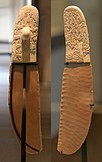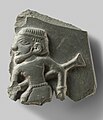前王朝時期
史前埃及 前王朝時期 | |||||||
|---|---|---|---|---|---|---|---|
 | |||||||
| |||||||
歷史系列條目 |
|---|
| 埃及歷史 |
 |
|
|
前王朝時期,又稱史前埃及,是從埃及最早的人類定居點開始,到公元前3100年左右第一王朝成立的時期,也是埃及文明的第一時期。而在史前時代結束後,「前王朝時期」在傳統上被定義為從新石器時代的最後部分(約公元前6200年)到涅伽達三期文化結束(約公元前3000年)的時期。約前40世紀,埃及人開始在各地建立城邦,當中包括底比斯、孟斐斯、布陀、希拉康波利斯、厄勒芬廷、阿拜多斯、提尼斯、賽伊斯、索伊斯、赫利奧波利斯、布巴斯提斯、坦尼斯,前王朝時代如是開始。直至前31世紀美尼斯統一上下埃及,前王朝時期結束,早王朝時期開始。
前王朝時期在時間上跨越的尺度在埃及大規模考古發掘就確定了,但後來關於埃及前王朝時期探索的進程十分緩慢,導致前王朝時期究竟何時結束的爭議。因此大家用各種如「原王朝時期」、「第零王朝」[1]來命名此時期和埃及早期王朝。前王朝時期通常被劃分為不同的文化,這些文化常常得名於首次發現該文化特徵的埃及定居點。然而,原始王朝時期的漸進式發展貫穿整個前王朝時期,各個「文化」不應被分別看待。這種主觀劃分只是為了便於研究整個時期。考古學家發現的絕大多數關於前王朝時期的遺址來自上埃及,因為尼羅河的淤泥在下埃及三角洲地區沉積得更為嚴重,掩埋了下埃及大部分的前王朝遺址。[2]
舊石器時代
[編輯]儘管有關早期埃及人類居住的證據稀少且零散,包括早期人類在內,埃及有人類居住的時間已有超過一百萬年(可能超過兩百萬年)。埃及最古老的考古發現是屬於奧都萬文化的石器,而這些石器的年代確定得不太準確。隨後,這些工具阿舍利文化的石器取代。[3]埃及最早的阿舍利文化遺址可追溯到大約40至30萬年前。[4]
瓦迪哈勒法
[編輯]一些已知最古老的建築結構是在埃及阿爾金8號遺址由考古學家瓦爾德瑪爾·赫米勒夫斯基(Waldemar Chmielewski)發現的,這個遺址位於蘇丹的瓦迪哈勒法。赫米勒夫斯基將這些結構的年代確定為公元前100,000年。[5]這些結構的遺蹟是深約30厘米,橫跨2米 × 1米的橢圓形坑洞。許多坑洞內有平坦的砂岩板,作為帳篷環,支撐着由皮革或樹枝製成的圓頂狀庇護所。這種類型的住所提供了居住的場所,但必要時也便於拆卸和運輸。這些可以輕鬆拆卸、移動和重新組裝結構為狩獵採集者提供了半永久的居住地。[5]
阿特拉工具
[編輯]
阿特拉文化[6]的工具製作技術大約在距今40000年進入埃及。[5]
霍爾穆桑工具
[編輯]埃及的霍爾穆桑文化開始於公元前42000年到32000年之間。[5]霍爾穆桑人不僅用石頭製作工具,還用動物骨頭和赤鐵礦。[5]他們還製作了類似美洲原住民的小箭頭,但並未發現弓。[5]霍爾穆桑文化大約在公元前16000年,隨着包括格邁安文化在內的其他文化的出現而結束。[7]
舊石器時代晚期
[編輯]埃及的舊石器時代晚期大約始於公元前30000年。[5]1980年發現的納茲萊特·哈特爾骨骼,在1982年根據年代介於距今35100年和30,360年九個樣本,測定其年代為33000年。[8]這具標本是非洲石器時代晚期最早的一段時間中唯一保存完整的現代人類骨骼。[9]
上埃及的法胡里亞舊石器時代晚期文化表明,在晚更新世,尼羅河谷存在一個相似的人群。對骨骼材料的研究顯示,其變化範圍與瓦迪哈勒法、傑貝勒薩哈巴和考姆翁布人群的骨骼碎片相似。
中石器時代
[編輯]哈爾凡和庫班尼亞文化
[編輯]哈爾凡和庫班尼亞這兩個密切相關的文化興盛於上尼羅河谷。哈爾凡文化位於蘇丹最北部,而庫班尼亞文化則位於上埃及。對於哈爾凡文化,只有四個放射性碳定年數據。席爾德(Schild)和溫多夫(Wendorf)於2014年排除了最早和最晚的日期,認為哈爾凡文化存在於距今約22.5-22.0千年前。[10]人們依靠大型牲畜和霍爾穆桑傳統的捕魚方式生存。更多的文物集中表明他們並非季節性游牧,而是長時間定居。哈法文化繼承自霍爾穆桑文化,[註 1][12][頁碼請求]而後者依靠專業的狩獵、捕魚和採集技術生存。這一文化的主要物質遺存是石器工具、石片和大量的岩畫。

塞比利亞文化
[編輯]塞比利亞文化開始於約公元前13000年,並消失於約公元前10000年。考古遺址中發現的花粉分析表明,塞比利亞文化(也稱為埃斯那文化)的人收集穀物,不過沒有發現用於種植的種子。[13]根據假設,穀物收集者的定居生活方式導致了戰爭的增加,對定居生活不利,並導致了這一文化的終結。[13]
卡丹文化
[編輯]卡丹文化,自公元前13000年至9000年,是中石器時代文化,考古證據表明,卡丹文化大約在15000年前起源於上埃及。[14][15]卡丹文化的生存方式持續了大約4000年,其特徵包括狩獵以及一種獨特的食物採集方式,如收集並食用野草和穀物。[14][15]卡丹文化系統性地澆灌、照料並收穫當地的植物,但穀物並未按有序的行列種植。[16]
上努比亞的約二十個考古遺址提供了卡丹文化為磨糧文化的證據。在薩哈巴達魯尼羅河階段初期,撒哈拉沙漠的乾旱導致利比亞綠洲的居民遷往到尼羅河谷時,卡丹文化的人群還沿着尼羅河進行野生穀物的採集。[13]卡丹文化其中一個遺址是傑貝勒薩哈巴墓地,其年代被確定為中石器時代。[17]
卡丹文化最早創造了鐮刀,還獨立創造了磨石,以幫助收集和處理植物性食物,並在食用之前進行加工。[18]然而,在公元前10000年狩獵採集者取代了他們之後,便沒有了使用這些工具的跡象。[18]
新石器時代至原始王朝時期
[編輯]尼羅河谷新石器時代文化的早期證據通常位於埃及北部,展示了新石器時代的生存方式,包括作物栽培和定居生活,以及公元前6千紀晚期開始的陶器生產。[19]
1947年,自然科學家弗雷德里克·法爾肯伯格(Frederick Falkenburger)基於大約1800個史前埃及顱骨樣本,注意到樣本間存在很大的差異。法爾肯伯格根據鼻指數、整體頭部和面部形態(包括寬度、眼窩結構等指標)將這些顱骨分類為四種類型:克羅馬儂類型、尼格羅類型、地中海類型和上述群體的混合類型。[20]同樣根據醫生兼人類學家尤金·斯特羅哈爾(Eugene Strouhal)1971年的研究,早期埃及人的顱骨測量數據被指定為北非的克羅馬農類型、地中海類型、東非的尼格羅類型以及中間/混合類型。[21]
根據費克里·A·哈桑教授的研究,考古和生物數據表明,埃及尼羅河谷的人口組成是沿海北非人、新石器時代撒哈拉人、尼羅特狩獵者和生活在尼羅河沿岸地區的原始努比亞人之間複雜互動的結果,並受到來自黎凡特的影響和移民遷徙。[22]
下埃及
[編輯]法尤姆B文化(加龍文化)
[編輯]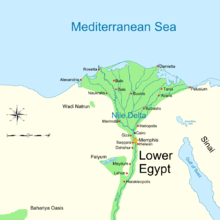
法尤姆B文化,也被稱為加龍文化,得名於加龍湖,是埃及上古石器時代(或中石器時代)的考古文化,位於法尤姆A文化之前。法尤姆B文化沒有發現陶器,刀刃類型包括普通石器和細石器。一組勺子和箭簇表明法尤姆B文化可能與撒哈拉有所接觸(約公元前6500年至公元前5190年)。[23][24]
馬切伊·亨內伯格(Maciej Henneberg,1989)紀錄了一個距今8000年的加龍文化老年女性頭骨,它與瓦迪哈勒法、現代黑人和澳大利亞土著有密切聯繫,與北非(梅克塔-阿法盧人,即古柏柏爾人)或者之後的原始地中海類型(卡普薩文化)的上古石器時代材料有明顯不同。頭骨具有折中的性質,一方面骨骼纖細,另一方面卻擁有較大的牙齒和沉重的下顎骨。[25]2021年S. O. Y. 凱塔的簡短報告中也得出了相似的結果,並說明了加龍文化與肯雅泰塔人的親緣關係。[26]
法尤姆A文化
[編輯]在公元前5400年至公元前4400年的新石器時代法尤姆地區,[27][23],沙漠的不斷擴大使得埃及人的祖先遷徙到尼羅河流域,並長久地定居下來。法尤姆A文化是尼羅河流域最早的農耕文化。[28]已發現的考古沉積物的特徵是凹底的投射物與陶器。[29]公元前6200年左右,新石器時代的定居點出現在整個埃及範圍內。一些基於生物形態學、[30]遺傳學[31][32][33][34][35]和考古學數據[36][37][38][39][40]的研究將這些定居點歸因於埃及和北非的新石器時代來自近東新月沃土的移民,他們將農業帶來了這裏。
人類學和後顱骨數據研究將法尤姆、梅里姆達和拜達里的最早農業人群與近東人群聯繫在一起。[41][42][43]考古證據還表明,近東的家養動物和植物被納入了現有的覓食策略,但是在緩慢發展後才逐漸形成了一種完整的生活方式。[註 2][45][46]最終,引入埃及的近東家養動物的名稱並不是蘇美爾語或原始閃米特語的借詞。[47][48]
然而,一些學者對這一觀點提出了質疑,他們引用了語言學、[49]體質人類學、[50]考古學[51][52][53]和遺傳學數據[54][55][56][57][58],這些數據不支持史前時期來自黎凡特的大規模遷移假說。歷史學家威廉·斯蒂布林(William Stiebling)和考古學家蘇珊·N·赫爾夫特(Susan N. Helft)認為,這一觀點認為古埃及人與努比亞人及其他撒哈拉人是同一原始人口群體,而有一些來自阿拉伯、黎凡特、北非和印歐人的基因輸入,這些人在埃及的漫長歷史中定居於此。另一方面,斯蒂布林和赫爾夫特承認,北非人群的遺傳研究通常表明在新石器時代或更早時期有大量近東人口的湧入。他們還補充說,目前關於古埃及DNA的研究很少,無法解釋這些問題。[59]
埃及學家伊恩·肖在2003年寫道:「人類學研究表明,前王朝時期的人口包括多種種族類型(尼格羅人種、地中海人種和歐洲人種)」,但在法老時期開始時的骨骼材料卻是最具爭議的。根據一些學者的觀點,人群變化的過程可能比先前假設的來自東方的快速征服更為緩慢,可能涉及來自敘利亞-巴勒斯坦地區的不同類型逐步通過東部三角洲滲透。[60]
法尤姆A文化首次出現了紡織。另一方面,與後來的埃及人不同,這一時期的人們將死者埋在離他們的居住地非常近的地方,有時甚至直接埋在定居點內。[61]
儘管考古遺址關於這一時期的信息有限,但對許多埃及語中「城市」一詞的研究,可以推測埃及人定居的原因。在上埃及,這一術語顯示定居的原因包括貿易、保護牲畜、洪水避難的高地以及神祇的聖地等因素。[62]
梅里姆達文化
[編輯]梅里姆達文化[63],自約公元前5000年至公元前4200年在下埃及蓬勃發展,目前發現的只有尼羅河三角洲西部邊緣的大型聚落遺址梅里姆達-貝尼-薩拉姆。梅里姆達文化與法尤姆A文化和黎凡特有密切聯繫。人們生活在小屋裏,製作簡單而沒有裝飾的陶器和石器。他們飼養牛、綿羊、山羊和豬,種植小麥、高粱和大麥。梅里姆達文化的人將逝者埋葬在定居點內,並製作泥塑。第一個真人大小的埃及泥塑頭像就是來自梅里姆達文化。[64]
埃爾-奧馬里文化
[編輯]埃爾-奧馬里文化[63]得名於開羅附近的小定居點。人們可能居住在小屋裏,但只有柱坑和坑洞留存。埃爾-奧馬里文化的陶器沒有裝飾,石器包括小石片、斧頭和鐮刀,而金屬尚不清楚。[65]埃爾-奧馬里文化遺址自公元前4000年到埃及古風時期的公元前3100年都有人居住。[66]
馬底文化
[編輯]
馬底文化,也被稱為布陀—馬底文化,大約自公元前4000年至公元前3500年,是下埃及重要的史前文化,與涅伽代一期和二期文化同期。[67]馬底文化得名於開羅附近的馬底,這裏也是布陀的所在地,並在從尼羅河三角洲到法尤姆地區的許多地方都有發現。馬底文化的特點是建築與技術的發展,而馬底文化的無裝飾陶瓷也延續了其先前的文化。[68]
馬底文化已經有了銅,同時發現了一些銅錛,陶器以手工製作,但是簡單而缺乏裝飾。黑頂陶器的發現證明馬底文化與其南方的涅伽達文化有聯繫。此外,還發現了許多從巴勒斯坦進口的容器,以及用黑色玄武岩製作的容器。[69]
馬底文化的人群生活在部分挖入地下的小屋裏。死者通常埋葬在墓地中,不過只有很少的隨葬品。馬底文化被涅伽達三期文化所取代,是通過征服還是滲透仍存在爭議。[70]
多年來,下埃及在統一以前的發展存在很大的爭議。近期在泰爾法卡、塞易斯和泰爾伊斯威德的發掘證實了這一點。總之,銅石並用時代的下埃及文化仍需要更多的研究。[71]
上埃及
[編輯]塔西文化
[編輯]塔西文化,自約公元前4500年出現在上埃及。塔西文化得名於尼羅河東岸艾斯尤特和艾赫米姆之間的塔西發現的墓葬。塔西文化組最早創造了一種紅色和棕色,同時頂部和內部塗成黑色的黑頂陶器[61] 。黑頂陶器對追溯前王朝時期的埃及非常重要。前王朝時期的日期較為模糊,因此弗林德斯·皮特里爵士發明了年代序列法,從而判斷相對日期。如果沒有絕對日期,任何前王朝遺址的相對日期都可以通過研究發掘的陶器來確定。
隨着前王朝時期的發展,陶器手柄的作用逐漸從實用功能轉變為裝飾功能。一個考古遺址中陶器作用的實用或裝飾程度可以用於確定遺址的相對日期。塔西文化陶器與拜達里文化陶器只有很小的差別,因而塔西文化和拜達里文化在範圍上有很大的重疊。[72] 從塔西文化開始,上埃及受到了下埃及文化的強烈影響。[73] 考古證據表明「塔西和拜達里文化時期尼羅河流域的定居點是早期非洲文化的外圍網絡,拜達里人、撒哈拉人、努比亞人和尼羅特人經常傳播非洲文化」[74] 埃及學家布魯斯•威廉姆斯(Bruce Williams)認為,塔西文化與新石器時代的蘇丹-撒哈拉傳統有很大關係,新石器時代的蘇丹-撒哈拉傳統從喀土穆以北延伸到蘇丹東古拉附近的地區。[75]
拜達里文化
[編輯]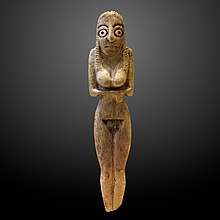
拜達里文化自公元前4400年至公元前4000年,[76]得名於塔西附近的拜達里。拜達里文化的時間在塔西文化之後,但因為兩者非常相似,許多人認為它們是一個連續的時期。巴拜達里文化繼續生產黑頂陶器,且質量有了很大提高,其年代序列編號為21到29。[72] 學者們沒有將這兩個時期合併的主要原因是,拜達里文化除了使用石器外還使用銅器,因此被認為是銅石並用時代的定居點,而塔西文化仍然被視為石器時代。[72]
拜達里文化的燧石工具繼續發展,變得更為鋒利而優美,並且出現了最早的陶釉製品。[77] 明確的拜達里遺址從尼肯一直延伸到阿拜多斯以北。[78]似乎法尤姆A文化與拜達里和塔西文化有明顯的重疊,然而,法尤姆A文化較少從事農業,仍然屬於新石器時代。[77][79] 許多生物人類學研究顯示,拜達里人與其他東北非洲人口有很強的生物親緣關係。[80][81][82][83][84][85] 然而,據尤金·斯特羅哈爾(Eugene Strouhal)和其他人類學家所述,拜達里文化的埃及人更類似於北非的卡普薩文化和柏柏爾人。[86]
2005年,凱塔(Keita)對上埃及前王朝時期的拜達裏頭骨與歐洲和熱帶非洲的各種頭骨進行比較,他發現拜達裏頭骨與熱帶非洲更為接近。不過,研究中沒有包括亞洲或其他北非的樣本,因為這項比較是基於「布雷斯(Brace)等人(1993年)關於上埃及/努比亞在舊石器時代晚期相似性的評論」選出的。凱塔進一步指出,來自蘇丹、晚期古埃及北方(吉薩)、索馬里、亞洲和太平洋島嶼的額外分析和材料表明,「拜達里與非洲東北部最為相似,之後才是其他非洲人」。[87]
對拜達里化石進行的牙齒特徵分析發現,他們與居住在東北非洲以及馬格里布的阿非羅-亞細亞語系人群有着密切關係。在古代人群中,拜達里人與其他古埃及人(上埃及的涅伽達、希拉孔波利斯、阿拜多斯和哈里傑綠洲;下埃及的哈瓦拉),以及在下努比亞發掘的C組文化和法老時代的遺骸最為接近,其次是下努比亞的A組文化、上努比亞的克爾瑪和庫施,以及下努比亞的麥羅埃、X組和基督教時期的居民,還有達赫拉綠洲的凱利斯人群。[88]:219–20在現代人群中,拜達里在形態上與阿爾及利亞的肖威亞和卡拜勒柏柏爾人群以及摩洛哥、利比亞和突尼斯的貝都因人群最為接近,其次是非洲之角的其他阿非羅-亞細亞語系人群。[88]:222–224 凱利斯出土的拜達里晚羅馬時期的骨骼在表型上也與撒哈拉以南非洲的其他人群明顯不同。[88]:231–32
奈加代文化
[編輯]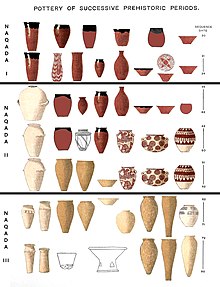
涅伽達文化也是銅石並用時代史前埃及的考古文化,時間自公元前4000年至公元前3000年,得名於埃及基納省的涅伽達。涅伽達文化分為三個子時期:涅伽達一期文化(阿姆拉特文化)、涅伽達二期文化(格爾津文化)和涅伽達三期文化(原始王朝時期)。
與先前的拜達里文化類似,研究發現涅伽達文化的骨骼遺骸具有東北非洲的特徵。[89][90][91][92][93][85]肖爾馬卡·凱塔(Shormaka Keita)的研究發現,涅伽達的遺骸符合兩種本地類型:南埃及的模式(與克爾馬最為相似)和北埃及的模式(與沿海馬格里布最為相似)。[94]
1996年,洛維爾(Lovell)和普羅斯(Prowse)報告了在涅伽達發現的被埋葬者,這些人被認為埋在高規格的貴族墓葬中,顯示他們是涅伽達本地人口中內婚制的統治階層或貴族,他們與努比亞北部(A組)的人群更為接近,而非與南埃及的鄰近人群。具體而言,他們指出,涅伽達的樣本「與下努比亞原始王朝時期樣本的相似度高於與地理上更接近的南埃及的基納和拜達里的樣本」。然而,他們發現涅伽達墓地的骨骼樣本與下努比亞的原始王朝時期人群,以及拜達里和基納的埃及原始王朝時期樣本都有明顯不同(這二者之間也有顯著不同)。[95]總體而言,涅伽達墓地中的貴族和非貴族個體彼此間更為相似,而與北努比亞的樣本或南埃及的拜達里和基納的樣本相較之下差異較大。[96]
2023年,克里斯托弗·埃雷特(Christopher Ehret)報告稱,「在公元前四千年古埃及起源地主要墓葬遺址(特別是拜達里和涅伽達)中的體質人類學研究發現,其人群沒有受到黎凡特人群的顯著影響。」埃雷特指出,研究揭示了這些頭骨和牙齒特徵與東北非洲周邊地區長期定居人口(如努比亞和非洲之角北部)有着最為密切的相似性。他進一步評論道,這些人口的成員並非來自其他地方,而是這些地區數千年以來長期居民的後代。埃雷特還引用現有的考古、語言和遺傳數據支持這段人群歷史。[97]
阿姆拉特文化(奈加代一期文化)
[編輯]
阿姆拉特文化,自公元前4000年至公元前3500年,[98] 得名於拜達里以南120公里的阿姆拉。阿姆拉是第一個發現這一文化的遺址,並且並沒有與格爾津文化混淆,但這一時期的文化在涅伽達得到了更好的詮釋,因此阿姆拉特文化也被稱為涅伽達一期文化。[99]黑頂陶器依然在這一時期出現,同時還發現了一種名為白色橫紋陶器,這種陶器上裝飾有一組緊密平行的白色線條,與另一組白色線條交叉。根據彼特里的年代序列法,阿姆拉特時期介於30期至39期之間。[100]
新發掘的物品證明了這一時期上埃及和下埃及之間的貿易有所增加。在阿姆拉發現了一隻來自北方的石制花瓶。另外還有銅,而埃及不產銅,銅可能是從西奈或者努比亞進口的,黑曜石[101]和少量的黃金[100]都明確來自努比亞。與綠洲之間的貿易也很可能存在。[101]
阿姆拉定居點出現了新技術的創新,為後期文化奠定了基礎。例如,格爾津文化以泥磚建築著稱,這些建築最早出現在阿姆拉特文化,雖然數量很少。[102] 此外,橢圓和動物形狀的調色板也出現在這一時期,但工藝非常粗糙,後來聞名的浮雕藝術尚未出現。[103][104]
格爾津文化(奈加代二期文化)
[編輯]
格爾津文化,自公元前3500年至公元前3200年,[105] 得名於遺址的發現地格爾津。它是埃及文化發展的下一階段,並奠定了埃及王朝的基礎。格爾津文化在很大程度上是從阿姆拉特文化發展而來的,影響範圍自尼羅河三角洲向南經過上埃及,但未能在努比亞取代阿姆拉特文化。[106]格爾津文化的陶器按年代序列法位列40至62,與阿姆拉特的白色橫紋陶器或黑頂陶器明顯不同。[107] 格爾澤陶器多為暗紅色,上面繪有動物、人物和船隻的圖案和可能來源於動物的幾何符號。[106]此外,「波浪形 」把手在這一時期之前非常罕見(雖然早在按年代序列法分期的第35期就偶爾發現),但在格爾津文化時期,「波浪形 」把手越來越常見,也越來越精緻,幾乎完全成為裝飾品。[107]
格爾津文化的興起恰逢降雨量大幅減少,[108]因而此時尼羅河沿岸的農業生產了絕大多數食物,[106] 儘管繪畫作品表明當時並沒有完全放棄狩獵。隨着糧食供應的增加,埃及人採用了更加定居的生活方式,城市也發展到 5000 座之多。[106]在這一時期,古埃及的城市居民停止使用蘆葦建造建築,開始大量生產泥磚(最早發現於阿姆拉特時期)來建造城市。[106]
古埃及人雖然仍在使用石器,但樣式已從雙面結構轉變為波紋片狀結構。銅被用於製作各種工具,[106]並出現了最早的銅製武器。[109]金、銀、青金石以及埃及彩陶被用於裝飾,[106] 而自拜達里文化時期起就用於眼部彩繪的陶製調色板上開始有了浮雕裝飾。[109]
第一批古典埃及風格的陵墓也已建成,這些陵墓仿照普通房屋建造,有時由多個房間組成。[110] 人們普遍認為這種陵墓風格起源於尼羅河三角洲地區(儘管還需要進一步發掘),而不是上埃及。[110]
儘管格爾津文化已被明確認定為阿姆拉特文化的延續,但在格爾津文化時期,美索不達米亞文化對埃及產生了重要影響。這種影響過去被王朝種族學說解釋為美索不達米亞統治階級掌管上埃及的證據,而這一觀點已不再對學術界有強烈的吸引力。
在這一時期,有明顯的外來物品和藝術形式進入埃及,表明埃及與亞洲多個地區有接觸。在埃及發現了格貝爾阿拉克刀的刀柄,上面有明顯的美索不達米亞浮雕圖案,[113] 而這一時期出現的銀器只能從小亞細亞獲得。[106]
此外還出現了明顯模仿美索不達米亞形式但又並非一味模仿的埃及物品。[114] 埃及出現了圓筒形印章以及嵌入式鑲板建築,化妝枱上的浮雕顯然與當時美索不達米亞烏魯克文化的風格相同,晚期格爾澤文化和早期「塞米諾文化」(即涅伽達三期文化)出土的禮儀用權杖頭是按照美索不達米亞的 「梨形 」風格製作的,而不是埃及本土風格。[108]
這條貿易路線很難確定,但埃及與迦南的接觸並不早於早期王朝時期,因此通常假定貿易是通過水路進行的。[115] 在王朝種族學說仍然流行的時候,有人推測是烏魯克水手跨越了阿拉伯半島,但埃及出現的比布魯斯物品證明,更有可能是通過比布魯斯的中間商經由地中海進行貿易。[115]
許多格爾津遺址都位於通往紅海的干河,表明有一定數量的貿易是通過紅海進行的,比布魯斯與埃及貿易路線可能自地中海穿過西奈半島,然後取道紅海。[116] 另外,嵌入式鑲板建築等複雜的技術不太可能通過間接方式進入埃及,通常懷疑至少有一小批移民帶來了這項技術。[115]
儘管有這些外來影響,埃及學家普遍認為,格爾津文化仍是埃及本土文化。
原始王朝時期(奈加代三期文化)
[編輯]
涅伽達三期文化,約公元前 3200 年至公元前 3000 年,[117]通常被認為與埃及統一之前的「原始王朝時期」(Protodynastic period)相同。 在涅伽達三期文化時期,首次出現了象形文字(目前存在爭議),首次有規律地使用塞拉赫紋章,首次進行灌溉並且首次出現了王室墓地。[118]
生物考古學家南希·洛弗爾(Nancy Lovell)指出,有足夠多的形態學證據表明,古埃及南方人的身體特徵「在撒哈拉和熱帶非洲古今土著人的變化範圍之內」,並總結道:「總的來說,上埃及和努比亞的居民與撒哈拉和更南部地區的居民在生物學上最相近」,[120]但在在非洲範圍內又表現出差異。[121]
-
前王朝時期帶有王室夫婦的權杖碎片,現藏於慕尼黑國家埃及藝術收藏館(Staatliche Sammlung für Ägyptische Kunst)
-
描繪了一個人和一支手杖的禮儀調色板殘片,約公元前3200 - 公元前3100年,前王朝時期涅伽達三期文化晚期
下努比亞
[編輯]納巴塔沙漠盆地
[編輯]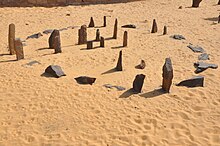
納巴塔沙漠盆地曾是努比亞沙漠中的一個大型內流盆地,位於現代開羅以南約800公里[122],以及阿布辛拜勒以西約100公里[123],具體位置是北緯22.51度,東經30.73度。如今該地區有許多考古遺址。納巴塔沙漠盆地的考古遺址是埃及新石器時代最早的遺址之一,可以追溯到約公元前7500年。[124][125]發掘表明,該地區新石器時代的居民包括來自撒哈拉以南非洲和地中海地區的移民。[126][127]根據克里斯托弗·埃雷特的研究,物質文化指標顯示,更大範圍的納巴塔沙漠區域居民是尼羅-撒哈拉語系人群。[128]
時間線
[編輯](所有日期均為近似日期)
- 舊石器時代晚期,始於公元前40000年
- 新石器時代,始於公元前 11 世紀
- 約公元前10500年:尼羅河沿岸收穫了野生穀物,穀物磨製文化創造了世界上最早的石制鐮刀,[18]時間大致在更新世末期
- 約公元前8000年:人們遷徙到尼羅河,發展出更加集中的社會和定居的農業經濟
- 約公元前7500年:從亞洲向撒哈拉引入動物
- 約公元前7000年:東撒哈拉發展出包括畜牧業和穀物業在內的農業;在納巴塔開鑿了深層的常年水井,並設計有計劃安排的大型有組織居住區
- 約公元前6000年:埃及岩畫中出現了初級船隻,如划船和單帆船
- 約公元前5500年:納巴塔出現有石頂的地下墓室和其他地下建築群,裏面埋葬着祭牛
- 約公元前5000年:考古發現了納巴塔的天文巨石;[129][130]拜達里文化中發現了家具、餐具、長方形的房屋模型、壺、碟、杯、碗、花瓶、雕像以及梳子
- 約公元前4400年: 精細編織的亞麻布碎片[131]
- 從公元前4000年開始,出現了各種先進的創造
相對年表
[編輯]相關條目
[編輯]註釋
[編輯]參考資料
[編輯]- ^ Leprohon, Ronald, J. The great name : ancient Egyptian royal titulary. Society of Biblical Literature. 2013. ISBN 978-1-58983-735-5.
- ^ Redford, Donald B. Egypt, Canaan, and Israel in Ancient Times
 . Princeton: University Press. 1992: 10. ISBN 9780691036069.
. Princeton: University Press. 1992: 10. ISBN 9780691036069.
- ^ Bakry, Aboualhassan; Saied, Ahmed; Ibrahim, Doaa. The Oldowan in the Egyptian Nile Valley. Journal of African Archaeology. 2020-07-21, 18 (2): 229–241. ISSN 1612-1651. doi:10.1163/21915784-20200010.
- ^ Michalec, Grzegorz; Cendrowska, Marzena; Andrieux, Eric; Armitage, Simon J.; Ehlert, Maciej; Kim, Ju Yong; Sohn, Young Kwan; Krupa-Kurzynowska, Joanna; Moska, Piotr; Szmit, Marcin; Masojć, Mirosław. A Window into the Early–Middle Stone Age Transition in Northeastern Africa—A Marine Isotope Stage 7a/6 Late Acheulean Horizon from the EDAR 135 Site, Eastern Sahara (Sudan). Journal of Field Archaeology. 2021-11-17, 46 (8): 513–533. ISSN 0093-4690. doi:10.1080/00934690.2021.1993618 (英語).
- ^ 5.0 5.1 5.2 5.3 5.4 5.5 5.6 Ancient Egyptian Culture: Paleolithic Egypt. Emuseum. Minnesota: Minnesota State University. [13 April 2012]. (原始內容存檔於1 June 2010).
- ^ 潘華瓊. 非洲考古与人类的“摇篮”. 中國投資(中英文). 2020, (Z2): 96-97.
- ^ Nicolas-Christophe Grimal. A History of Ancient Egypt. p. 20. Blackwell (1994). ISBN 0-631-19396-0
- ^ Dental Anthropology (PDF). Anthropology.osu.edu. [2013-10-25]. (原始內容 (PDF)存檔於29 October 2013). 已忽略未知參數
|df=(幫助) - ^ Bouchneba, L.; Crevecoeur, I. The inner ear of Nazlet Khater 2 (Upper Paleolithic, Egypt). Journal of Human Evolution. 2009, 56 (3): 257–262. Bibcode:2009JHumE..56..257B. PMID 19144388. doi:10.1016/j.jhevol.2008.12.003.
- ^ R. Schild; F. Wendorf. Late Palaeolithic Hunter-Gatherers in the Nile Valley of Nubia and Upper Egypt. E A. A. Garcea (編). South-Eastern Mediterranean Peoples Between 130,000 and 10,000 years ago. Oxbow Books: 89–125. 2014.
- ^ Prehistory of Nubia. Numibia.net. [2013-10-25]. (原始內容存檔於29 October 2013). 已忽略未知參數
|df=(幫助) - ^ Reynes, Midant-Beatrix. The Prehistory of Egypt: From the First Egyptians to the First Pharohs. Wiley-Blackwell. 2000. ISBN 0-631-21787-8.
- ^ 13.0 13.1 13.2 Grimal, Nicolas. A History of Ancient Egypt. Librairie Arthéme Fayard. 1988: 21.
- ^ 14.0 14.1 Phillipson, DW: African Archaeology p. 149. Cambridge University Press, 2005.
- ^ 15.0 15.1 Shaw, I & Jameson, R: A Dictionary of Archaeology, p. 136. Blackwell Publishers Ltd, 2002.
- ^ Darvill, T: The Concise Oxford Dictionary of Archaeology, Copyright © 2002, 2003 by Oxford University Press.
- ^ Kelly, Raymond. The evolution of lethal intergroup violence. PNAS. October 2005, 102 (43): 24–29. Bibcode:2005PNAS..10215294K. PMC 1266108
 . PMID 16129826. doi:10.1073/pnas.0505955102
. PMID 16129826. doi:10.1073/pnas.0505955102  .
.
- ^ 18.0 18.1 18.2 18.3 18.4 18.5 Ancient Egyptian Culture: Paleolithic Egypt. Emuseum. Minnesota: Minnesota State University. [13 April 2012]. (原始內容存檔於1 June 2010).
- ^ Köhler, E. Christiana. Neolithic in the Nile Valley (Fayum A, Merimde, el-Omari, Badarian). Archéo-Nil. 2011, 21 (1): 17–20. doi:10.3406/arnil.2011.1023.
- ^ Boëtsch, Gilles. Noirs ou blancs : une histoire de l'anthropologie biologique de l'Égypte. Égypte/Monde arabe. 1995-12-31, (24): 113–138. ISSN 1110-5097. doi:10.4000/ema.643 (法語).
Falkenburger also notes a great heterogeneity in the measurements taken on 1,800 Egyptian skulls. From indices expressing the shape of the face, nose and orbits, Falkenburger divides the ancient Egyptians into four types - Cro-Magnon type, Negroid type, Mediterranean type and mixed type, resulting from the mixture of the first three.
- ^ Strouhal, Eugen. Evidence of the early penetration of Negroes into prehistoric Egypt. The Journal of African History. 1971-01-01, 12 (1): 1–9. ISSN 1469-5138. doi:10.1017/S0021853700000037 (英語).
- ^ Hassan, Fekri A. The Predynastic of Egypt. Journal of World Prehistory. 1988-06-01, 2 (2): 135–185. ISSN 1573-7802. doi:10.1007/BF00975416 (英語).
- ^ 23.0 23.1 Fayum, Qarunian (Fayum B) (about 6000-5000 BC?). Digital Egypt for Universities. University College London. [September 23, 2024].
- ^ Ki-Zerbo[editor], Joseph. General history of Africa, abridged edition, v. 1: Methodology and African prehistory. UNESCO Digital Library. The University of California Press: 281. 1989 [September 23, 2024].
- ^ Hendrickx, Stan; Claes, Wouter; Tristant, Yann. IFAO - Bibliographie de l'Égypte des Origines : #2998 = The Early Neolithic, Qarunian burial from the Northern Fayum Desert (Egypt). www.ifao.egnet.net. [2024-09-24] (法語).
- ^ Keita, S.O.Y. Title: Short Report: Morphometric Affinity of the Qarunian Early Egyptian Skull Explored With Fordisc 3.0. Academia.edu. 2020-08-01.
- ^ Köhler, E. Christiana. Neolithic in the Nile Valley (Fayum A, Merimde, el-Omari, Badarian). Archéo-Nil. 2011, 21 (1): 17–20. doi:10.3406/arnil.2011.1023.
- ^ Köhler, E. Christiana. Neolithic in the Nile Valley (Fayum A, Merimde, el-Omari, Badarian). Archéo-Nil. 2011, 21 (1): 17–20. doi:10.3406/arnil.2011.1023.
- ^ Redford, Donald B. Egypt, Canaan, and Israel in Ancient Times
 . Princeton: University Press. 1992: 6. ISBN 9780691036069.
. Princeton: University Press. 1992: 6. ISBN 9780691036069.
- ^ Brace, C. Loring; Seguchi, Noriko; Quintyn, Conrad B.; Fox, Sherry C.; Nelson, A. Russell; Manolis, Sotiris K.; Qifeng, Pan. The questionable contribution of the Neolithic and the Bronze Age to European craniofacial form. Proceedings of the National Academy of Sciences of the United States of America. 2006, 103 (1): 242–247. Bibcode:2006PNAS..103..242B. PMC 1325007
 . PMID 16371462. doi:10.1073/pnas.0509801102
. PMID 16371462. doi:10.1073/pnas.0509801102  .
.
- ^ Chicki, L; Nichols, RA; Barbujani, G; Beaumont, MA. Y genetic data support the Neolithic demic diffusion model. Proc. Natl. Acad. Sci. USA. 2002, 99 (17): 11008–11013. Bibcode:2002PNAS...9911008C. PMC 123201
 . PMID 12167671. doi:10.1073/pnas.162158799
. PMID 12167671. doi:10.1073/pnas.162158799  .
.
- ^ Estimating the Impact of Prehistoric Admixture on the Genome of Europeans, Dupanloup et al., 2004. Mbe.oxfordjournals.org. [1 May 2012]. (原始內容存檔於11 March 2007).
- ^ Semino, O; Magri, C; Benuzzi, G; et al. Origin, Diffusion, and Differentiation of Y-Chromosome Haplogroups E and J: Inferences on the Neolithization of Europe and Later Migratory Events in the Mediterranean Area, 2004. Am. J. Hum. Genet. May 2004, 74 (5): 1023–34. PMC 1181965
 . PMID 15069642. doi:10.1086/386295.
. PMID 15069642. doi:10.1086/386295.
- ^ Cavalli-Sforza. Paleolithic and Neolithic lineages in the European mitochondrial gene pool. Am J Hum Genet. 1997, 61 (1): 247–54 [1 May 2012]. PMC 1715849
 . PMID 9246011. doi:10.1016/S0002-9297(07)64303-1.
. PMID 9246011. doi:10.1016/S0002-9297(07)64303-1.
- ^ Chikhi. Clines of nuclear DNA markers suggest a largely Neolithic ancestry of the European gene. PNAS. 21 July 1998, 95 (15): 9053–9058. Bibcode:1998PNAS...95.9053C. PMC 21201
 . PMID 9671803. doi:10.1073/pnas.95.15.9053
. PMID 9671803. doi:10.1073/pnas.95.15.9053  .
.
- ^ Bar Yosef, Ofer. The Natufian Culture in the Levant, Threshold to the Origins of Agriculture. Evolutionary Anthropology. 1998, 6 (5): 159–177. S2CID 35814375. doi:10.1002/(sici)1520-6505(1998)6:5<159::aid-evan4>3.0.co;2-7.
- ^ Zvelebil, M. Hunters in Transition: Mesolithic Societies and the Transition to Farming. Cambridge, UK: Cambridge University Press. 1986: 5–15, 167–188.
- ^ Bellwood, P. First Farmers: The Origins of Agricultural Societies. Malden, MA: Blackwell. 2005.
- ^ Dokládal, M.; Brožek, J. Physical Anthropology in Czechoslovakia: Recent Developments. Current Anthropology. 1961, 2 (5): 455–477. S2CID 161324951. doi:10.1086/200228.
- ^ Zvelebil, M. On the transition to farming in Europe, or what was spreading with the Neolithic: a reply to Ammerman (1989). Antiquity. 1989, 63 (239): 379–383. S2CID 162882505. doi:10.1017/S0003598X00076110.
- ^ Smith, P. (2002) The palaeo-biological evidence for admixture between populations in the southern Levant and Egypt in the fourth to third millennia BC. In: Egypt and the Levant: Interrelations from the 4th through the Early 3rd Millennium BC, London–New York: Leicester University Press, 118–128
- ^ Keita, S.O.Y. Early Nile Valley Farmers from El-Badari: Aboriginals or "European" Agro-Nostratic Immigrants? Craniometric Affinities Considered With Other Data. Journal of Black Studies. 2005, 36 (2): 191–208. S2CID 144482802. doi:10.1177/0021934704265912.
- ^ Kemp, B. 2005 "Ancient Egypt Anatomy of a Civilisation". Routledge. p. 52–60
- ^ Shirai, Noriyuki. The Archaeology of the First Farmer-Herders in Egypt: New Insights into the Fayum Epipalaeolithic. Archaeological Studies Leiden University. Leiden University Press. 2010.
- ^ Wetterstrom, W. Shaw, T.; et al , 編. Archaeology of Africa. London: Routledge. 1993: 165–226.
- ^ Rahmani, N. Le Capsien typique et le Capsien supérieur. Cambridge Monographs in Archaeology (Cambridge: Cambridge University Press). 2003, (57).
- ^ Keita, S. O. Y.; Boyce, A. J. Genetics, Egypt and History: Interpreting Geographical Patterns of a Y-Chromosome Variation. History in Africa. 2005, 32: 221–46. S2CID 163020672. doi:10.1353/hia.2005.0013.
- ^ Ehret, C; Keita, SOY; Newman, P. The Origins of Afroasiatic a response to Diamond and Bellwood (2003). Science. 2004, 306 (5702): 1680. PMID 15576591. S2CID 8057990. doi:10.1126/science.306.5702.1680c.
- ^ Ehret, Christopher. Ancient Africa: A Global History, to 300 CE. Princeton: Princeton University Press. 20 June 2023: 82–85. ISBN 978-0-691-24409-9 (英語).
- ^ Zakrzewski, Sonia R. Population continuity or population change: Formation of the ancient Egyptian state. American Journal of Physical Anthropology. April 2007, 132 (4): 501–509. PMID 17295300. doi:10.1002/ajpa.20569 (英語).
- ^ "There is no evidence, no archaeological signal, for a mass migration (settler colonization)" into Egypt from southwest Asia at the time of the writing. Core Egyptian culture was well established. A total peopling of Egypt at this time from the Near East would have meant the mass migration of Semitic speakers. The ancient Egyptian language – using the usual academic language taxonomy – is a branch within Afroasiatic with one member (not counting place of origin/urheimat is within Africa, using standard linguistic criteria based on the locale of greatest diversity, deepest branches, and least moves accounting for its five or six branches or sevem, if Ongota is counted".Template:Verify inline Keita, S. O. Y. Ideas about 'Race' in Nile Valley Histories: A Consideration of 'Racial' Paradigms in Recent Presentations on Nile Valley Africa, from 'Black Pharaohs' to Mummy Genomest. Journal of Ancient Egyptian Interconnections. September 2022.
- ^ Wengrow, David; Dee, Michael; Foster, Sarah; Stevenson, Alice; Ramsey, Christopher Bronk. Cultural convergence in the Neolithic of the Nile Valley: a prehistoric perspective on Egypt's place in Africa. Antiquity. March 2014, 88 (339): 95–111. ISSN 0003-598X. S2CID 49229774. doi:10.1017/S0003598X00050249
 (英語).
(英語).
- ^ Redford, Donald. The Oxford Encyclopedia of Ancient Egypt. Oxford University Press. 2001: 27–28. ISBN 978-0195102345.
- ^ "P2 (PN2) marker, within the E haplogroup, connects the predominant Y chromosome lineage found in Africa overall after the modern human left Africa. P2/M215-55 is found from the Horn of Africa up through the Nile Valley and west to the Maghreb, and P2/V38/M2 is predominant in most of infra-Saharan tropical Africa". Shomarka, Keita. Ancient Egyptian 'Origins' and 'Identity'. Ancient Egyptian society: challenging assumptions, exploring approaches. Abingdon, Oxfordshire: Routledge. 2022: 111–122. ISBN 978-0367434632.
- ^ "Moreover, the available genetic evidence – relating in particular to the M35/215 Y-chromosome lineage – also accords with just this kind of demographic history. This lineage had its origins broadly in the Horn of Africa and East Africa." Ehret, Christopher. Ancient Africa: A Global History, to 300 CE. Princeton University Press. 20 June 2023: 97. ISBN 978-0-691-24410-5 (英語).
- ^ Trombetta, B.; Cruciani, F.; Sellitto, D.; Scozzari, R. A new topology of the human Y chromosome haplogroup E1b1 (E-P2) revealed through the use of newly characterized binary polymorphisms. PLOS ONE. 2011, 6 (1): e16073. Bibcode:2011PLoSO...616073T. PMC 3017091
 . PMID 21253605. doi:10.1371/journal.pone.0016073
. PMID 21253605. doi:10.1371/journal.pone.0016073  .
.
- ^ Cruciani, Fulvio; et al. Tracing Past Human Male Movements in Northern/Eastern Africa and Western Eurasia: New Clues from Y-Chromosomal Haplogroups E-M78 and J-M12. Molecular Biology and Evolution. June 2007, 24 (6): 1300–1311. PMID 17351267. doi:10.1093/molbev/msm049.
- ^ Anselin, Alain H. Egypt in its African context: proceedings of the conference held at the Manchester Museum, University of Manchester, 2-4 October 2009. Oxford: Archaeopress. 2011: 43–54. ISBN 978-1407307602.
- ^ Stiebing, William H. Jr.; Helft, Susan N. Ancient Near Eastern History and Culture. Taylor & Francis. 3 July 2023: 209–212. ISBN 978-1-000-88066-3 (英語).
- ^ Shaw, Ian. The Oxford History of Ancient Egypt. OUP Oxford. 2003-10-23: 309. ISBN 978-0-19-160462-1 (英語).
- ^ 61.0 61.1 Gardiner, Alan. Egypt of the Pharaohs. Oxford: University Press. 1964: 388.
- ^ Redford, Donald B. Egypt, Canaan, and Israel in Ancient Times
 . Princeton: University Press. 1992: 8. ISBN 9780691036069.
. Princeton: University Press. 1992: 8. ISBN 9780691036069.
- ^ 63.0 63.1 郭小瑞. 古埃及早期社会分层的缘起. 外國問題研究. 2023, (01): 48-59+143. doi:10.16225/j.cnki.wgwtyj.2023.01.006.
- ^ Eiwanger, Josef. Merimde Beni-salame. Bard, Kathryn A. (編). Encyclopedia of the Archaeology of Ancient Egypt
 . London/New York: Routledge. 1999: 501–505. ISBN 9780415185899.
. London/New York: Routledge. 1999: 501–505. ISBN 9780415185899.
- ^ Mortensen, Bodil. el-Omari. Bard, Kathryn A. (編). Encyclopedia of the Archaeology of Ancient Egypt
 . London/New York: Routledge. 1999: 592–594. ISBN 9780415185899.
. London/New York: Routledge. 1999: 592–594. ISBN 9780415185899.
- ^ El-Omari. EMuseum. Mankato: Minnesota State University. (原始內容存檔於15 June 2010).
- ^ "Maadi", University College London.
- ^ Mark, Joshua J. Predynastic Period in Egypt. World History Encyclopedia. 18 January 2016 [2017-11-14].
- ^ "Maadi", University College London.
- ^ Seeher, Jürgen. Ma'adi and Wadi Digla
 . Bard, Kathryn A. (編). Encyclopedia of the Archaeology of Ancient Egypt. London/New York: Routledge: 455–458. 1999. ISBN 9780415185899.
. Bard, Kathryn A. (編). Encyclopedia of the Archaeology of Ancient Egypt. London/New York: Routledge: 455–458. 1999. ISBN 9780415185899.
- ^ Mączyńska, Agnieszka. On the Transition Between the Neolithic and Chalcolithic in Lower Egypt and the Origins of the Lower Egyptian Culture: a Pottery Study (PDF). Desert and the Nile. Prehistory of the Nile Basin and the Sahara. 2018. (原始內容 (PDF)存檔於March 27, 2023).
- ^ 72.0 72.1 72.2 Gardiner, Alan, Egypt of the Pharaohs (Oxford: University Press, 1964), p. 389.
- ^ Grimal, Nicolas. A History of Ancient Egypt. p.35. Librairie Arthéme Fayard, 1988.
- ^ Excell, Karen. Egypt in its African context: proceedings of the conference held at the Manchester Museum, University of Manchester, 2–4 October 2009. Oxford: Archaeopress. 2011: 43–54. ISBN 978-1407307602.
- ^ Williams, Bruce. The Qustul Incense Burner and the Case for a Nubian Origin of Ancient Egyptian Kingship. Celenko, Theodore (編). Egypt in Africa. Indianapolis, Indiana: Indianapolis Museum of Art. 1996: 95–97. ISBN 978-0936260648.
- ^ Shaw, Ian (編). The Oxford History of Ancient Egypt. Oxford University Press. 2000: 479. ISBN 0-19-815034-2.
- ^ 77.0 77.1 Grimal, Nicolas. A History of Ancient Egypt. p.24. Librairie Arthéme Fayard, 1988
- ^ Gardiner, Alan, Egypt of the Pharaohs (Oxford: University Press, 1964), p. 391.
- ^ Newell, G. D. (2012). "A re-examination of the Badarian Culture". MA thesis.
- ^ "When Mahalanobis D2 was used,the Naqadan and Badarian Predynastic samples exhibited more similarity to Nubian, Tigrean, and some more southern series than to some mid- to late Dynasticseries from northern Egypt (Mukherjee et al., 1955). The Badarian have been found to be very similar to a Kerma sample (Kushite Sudanese), using both the Penrose statistic (Nutter, 1958) and DFA of males alone (Keita, 1990). Furthermore, Keita considered that Badarian males had a southern modal phenotype, and that together with a Naqada sample, they formed a southern Egyptian cluster as tropical variants together with a sample from Kerma". Zakrzewski, Sonia R. Population continuity or population change: Formation of the ancient Egyptian state. American Journal of Physical Anthropology. April 2007, 132 (4): 501–509. PMID 17295300. doi:10.1002/ajpa.20569 (英語).
- ^ Keita, S. O. Y. Early Nile Valley Farmers From El-Badari: Aboriginals or 'European' Agro-Nostratic Immigrants? Craniometric Affinities Considered With Other Data. Journal of Black Studies. 2005, 36 (2): 191–208. ISSN 0021-9347. JSTOR 40034328. S2CID 144482802. doi:10.1177/0021934704265912.
- ^ Godde, Kanya. A biological perspective of the relationship between Egypt, Nubia, and the Near East during the Predynastic period. [20 February 2022].
- ^ S. O. Y., Keita; A. J., Boyce. Temporal variation in phenetic affinity of early Upper Egyptian male cranial series. Human Biology. 2008, 80 (2): 141–159. ISSN 0018-7143. PMID 18720900. S2CID 25207756. doi:10.3378/1534-6617(2008)80[141:TVIPAO]2.0.CO;2 (英語).
- ^ "Keita (1992), using craniometrics, discovered that the Badarian series is distinctly different from the later Egyptian series, a conclusion that is mostly confirmed here. In the current analysis, the Badari sample more closely clusters with the Naqada sample and the Kerma sample". Godde, K. An examination of Nubian and Egyptian biological distances: support for biological diffusion or in situ development?. Homo: Internationale Zeitschrift für die vergleichende Forschung am Menschen. 2009, 60 (5): 389–404. ISSN 1618-1301. PMID 19766993. doi:10.1016/j.jchb.2009.08.003.
- ^ 85.0 85.1 Ehret, Christopher. Ancient Africa: A Global History, to 300 CE. Princeton: Princeton University Press. 20 June 2023: 84–85. ISBN 978-0-691-24409-9 (英語).
- ^ Strohaul, Eugene. Anthropology of the Egyptian Nubian Men - Strouhal - 2007 - ANTHROPOLOGIE (PDF). Puvodni.MZM.cz: 115.
- ^ Keita, S. O. Y. Early Nile Valley Farmers From El-Badari: Aboriginals or 'European' Agro-Nostratic Immigrants? Craniometric Affinities Considered With Other Data. Journal of Black Studies. November 2005, 36 (2): 191–208. ISSN 0021-9347. S2CID 144482802. doi:10.1177/0021934704265912 (英語).
- ^ 88.0 88.1 88.2 Haddow, Scott Donald. Dental Morphological Analysis of Roman Era Burials from the Dakhleh Oasis, Egypt. Institute of Archaeology, University College London. January 2012 [2 June 2017].
- ^ "When Mahalanobis D2 was used, the Naqadan and Badarian Predynastic samples exhibited more similarity to Nubian, Tigrean, and some more southern series than to some mid- to late Dynasticseries from northern Egypt (Mukherjee et al., 1955). The Badarian have been found to be very similar to a Kerma sample (Kushite Sudanese), using both the Penrose statistic (Nutter, 1958) and DFA of males alone (Keita, 1990). Furthermore, Keita considered that Badarian males had a southern modal phenotype, and that together with a Naqada sample, they formed a southern Egyptian cluster as tropical variants together with a sample from Kerma". Zakrzewski, Sonia R. Population continuity or population change: Formation of the ancient Egyptian state. American Journal of Physical Anthropology. April 2007, 132 (4): 501–509. PMID 17295300. doi:10.1002/ajpa.20569 (英語).
- ^ Keita, S. O. Y. Studies and Comments on Ancient Egyptian Biological Relationships. History in Africa. 1993, 20: 129–154. ISSN 0361-5413. JSTOR 3171969. S2CID 162330365. doi:10.2307/3171969.
- ^ Keita, Shomarka. Analysis of Naqada Predynastic Crania: a brief report (PDF). 1996 [22 February 2022]. (原始內容 (PDF)存檔於5 December 2022).
- ^ Godde, K. An examination of Nubian and Egyptian biological distances: support for biological diffusion or in situ development?. Homo: Internationale Zeitschrift für die Vergleichende Forschung am Menschen. 2009, 60 (5): 389–404. ISSN 1618-1301. PMID 19766993. doi:10.1016/j.jchb.2009.08.003.
- ^ Godde, Kanya. A biological perspective of the relationship between Egypt, Nubia, and the Near East during the Predynastic period. Egypt at its Origins 6: Proceedings of the Sixth International Conference "Origin of the State. Predynastic and Early Dynastic Egypt". Vienna: Peeters. 2020. 已忽略未知參數
|orig-date=(幫助) - ^ Keita, Shomarka. Analysis of Naqada Predynastic Crania: a brief report (1996) (PDF). [2022-02-22]. (原始內容 (PDF)存檔於2022-12-05).
- ^ Lovell, Nancy; Prowse, Tracy. Concordance of cranial and dental morphological traits and evidence for endogamy in ancient Egypt. American Journal of Physical Anthropology. October 1996, 101 (2): 237–246. PMID 8893087. doi:10.1002/(SICI)1096-8644(199610)101:2<237::AID-AJPA8>3.0.CO;2-Z.
Table 3 presents the MMD data for Badari, Qena, and Nubia in addition to Naqada and shows that these samples are all significantly different from each other. ... 1) the Naqada samples are more similar to each other than they are to the samples from the neighbouring Upper Egyptian or Lower Nubian sites and 2) the Naqada samples are more similar to the Lower Nubian protodynastic sample than they are to the geographically more proximate Egyptian samples.
- ^ Lovell, Nancy; Prowse, Tracy. Concordance of cranial and dental morphological traits and evidence for endogamy in ancient Egypt. American Journal of Physical Anthropology. October 1996, 101 (2): 237–246. PMID 8893087. doi:10.1002/(SICI)1096-8644(199610)101:2<237::AID-AJPA8>3.0.CO;2-Z.
... the Naqada samples are more similar to each other than they are to the samples from the neighbouring Upper Egyptian or Lower Nubian sites ...
- ^ Ehret, Christopher. Ancient Africa: A Global History, to 300 CE. Princeton: Princeton University Press. 20 June 2023: 82–85, 97. ISBN 978-0-691-24409-9 (英語).
- ^ Shaw, Ian (編). The Oxford History of Ancient Egypt. Oxford University Press. 2000: 479. ISBN 0-19-815034-2.
- ^ Grimal, Nicolas. A History of Ancient Egypt. p.24. Librairie Arthéme Fayard, 1988
- ^ 100.0 100.1 Gardiner, Alan, Egypt of the Pharaohs (Oxford: University Press, 1964), p. 390.
- ^ 101.0 101.1 Grimal, Nicolas. A History of Ancient Egypt. p. 28. Librairie Arthéme Fayard, 1988
- ^ Redford, Donald B. (1992). Egypt, Canaan, and Israel in Ancient Times. Princeton: University Press, p. 7.
- ^ Gardiner, Alan (1964), Egypt of the Pharaohs. Oxford: University Press, p. 393.
- ^ Newell, G. D., "The Relative chronology of PNC I" (Academia.Edu: 2012)
- ^ Shaw, Ian (編). The Oxford History of Ancient Egypt. Oxford University Press. 2000: 479. ISBN 0-19-815034-2.
- ^ 106.0 106.1 106.2 106.3 106.4 106.5 106.6 106.7 Redford, Donald B. Egypt, Canaan, and Israel in Ancient Times. (Princeton: University Press, 1992), p. 16.
- ^ 107.0 107.1 Gardiner, Alan, Egypt of the Pharaohs (Oxford: University Press, 1964), p. 390.
- ^ 108.0 108.1 Redford, Donald B. Egypt, Canaan, and Israel in Ancient Times. (Princeton: University Press, 1992), p. 17.
- ^ 109.0 109.1 Gardiner, Alan, Egypt of the Pharaohs (Oxford: University Press, 1964), p. 391.
- ^ 110.0 110.1 Grimal, Nicolas. A History of Ancient Egypt. p. 28. Librairie Arthéme Fayard, 1988
- ^ 111.0 111.1 Site officiel du musée du Louvre. cartelfr.louvre.fr.
- ^ Cooper, Jerrol S. The Study of the Ancient Near East in the Twenty-first Century: The William Foxwell Albright Centennial Conference. Eisenbrauns. 1996: 10–14. ISBN 9780931464966 (英語).
- ^ Shaw, Ian & Nicholson, Paul, The Dictionary of Ancient Egypt (London: British Museum Press, 1995), p. 109.
- ^ Redford, Donald B. Egypt, Canaan, and Israel in Ancient Times. (Princeton: University Press, 1992), p. 18.
- ^ 115.0 115.1 115.2 Redford, Donald B. Egypt, Canaan, and Israel in Ancient Times. (Princeton: University Press, 1992), p. 22.
- ^ Redford, Donald B. Egypt, Canaan, and Israel in Ancient Times. (Princeton: University Press, 1992), p. 20.
- ^ Shaw, Ian (編). The Oxford History of Ancient Egypt. Oxford University Press. 2000: 479. ISBN 0-19-815034-2.
- ^ Naqada III. Faiyum.com. [1 May 2012].
- ^ Maadi Culture. University College London. [3 April 2018].
- ^ "There is now a sufficient body of evidence from modern studies of skeletal remains to indicate that the ancient Egyptians, especially southern Egyptians, exhibited physical characteristics that are within the range of variation for ancient and modern indigenous peoples of the Sahara and tropical Africa. The distribution of population characteristics seems to follow a clinal pattern from south to north, which may be explained by natural selection as well as gene flow between neighboring populations. In general, the inhabitants of Upper Egypt and Nubia had the greatest biological affinity to people of the Sahara and more southerly areas". Lovell, Nancy C. Egyptians, physical anthropology of. Bard, Kathryn A.; Shubert, Steven Blake (編). Encyclopedia of the Archaeology of Ancient Egypt. London: Routledge: 328–331. 1999. ISBN 0415185890.
- ^ Lovell, Nancy C. Egyptians, physical anthropology of (PDF). Bard, Kathryn A.; Shubert, Steven Blake (編). Encyclopedia of the Archaeology of Ancient Egypt. London: Routledge: 328–331. 1999. ISBN 0415185890.
- ^ Slayman, Andrew L., Neolithic Skywatchers, Archaeological Institute of America, May 27, 1998
- ^ Wendorf, Fred; Schild, Romuald, Late Neolithic megalithic structures at Nabta Playa (Sahara), southwestern Egypt, Comparative Archaeology Web, November 26, 2000, (原始內容存檔於August 6, 2011)
- ^ Margueron, Jean-Claude. Le Proche-Orient et l'Égypte antiques. Hachette Éducation. 2012: 380. ISBN 9782011400963 (法語).
- ^ Wendorf, Fred; Schild, Romuald. Holocene Settlement of the Egyptian Sahara: Volume 1: The Archaeology of Nabta Playa. Springer Science & Business Media. 2013: 51–53. ISBN 9781461506539 (英語).
- ^ Wendorf, Fred. Holocene settlement of the Egyptian Sahara. New York: Kluwer Academic/Plenum Publishers. 2001: 489–502. ISBN 978-0-306-46612-0.
- ^ McKim Malville, J. Astronomy at Nabta Playa, Southern Egypt. Handbook of Archaeoastronomy and Ethnoastronomy. Springer. 2015: 1080–1090. ISBN 978-1-4614-6140-1. doi:10.1007/978-1-4614-6141-8_101.
- ^ Ehret, Christopher. Ancient Africa: A Global History, to 300 CE. Princeton University Press. 20 June 2023: 107. ISBN 978-0-691-24409-9 (英語).
- ^ Malville, J. McKim, Astronomy at Nabta Playa, Egypt, Ruggles, C.L.N. (編), Handbook of Archaeoastronomy and Ethnoastronomy 2, New York: Springer Science+Business Media: 1079–1091, 2015, ISBN 978-1-4614-6140-1
- ^ Belmonte, Juan Antonio, Ancient Egypt, Ruggles, Clive; Cotte, Michel (編), Heritage Sites of Astronomy and Archaeoastronomy in the context of the UNESCO World Heritage Convention: A Thematic Study, Paris: International Council on Monuments and Sites/International Astronomical Union: 119–129, 2010, ISBN 978-2-918086-07-9
- ^ linen fragment. Digitalegypt.ucl.ac.uk. [1 May 2012].
- ^ Shaw (2000), p. 61
- ^ Brooks, Nick. Cultural responses to aridity in the Middle Holocene and increased social complexity. Quaternary International. 2006, 151 (1): 29–49. Bibcode:2006QuInt.151...29B. doi:10.1016/j.quaint.2006.01.013.
- ^ "Iron beads were worn in Egypt as early as 4000 B.C., but these were of meteoric iron, evidently shaped by the rubbing process used in shaping implements of stone", quoted under the heading "Columbia Encyclopedia: Iron Age" at Iron Age, Answers.com. Also, see History of ferrous metallurgy#Meteoric iron—"Around 4000 BC small items, such as the tips of spears and ornaments, were being fashioned from iron recovered from meteorites" – attributed to R. F. Tylecote, A History of Metallurgy (2nd edition, 1992), p. 3.

